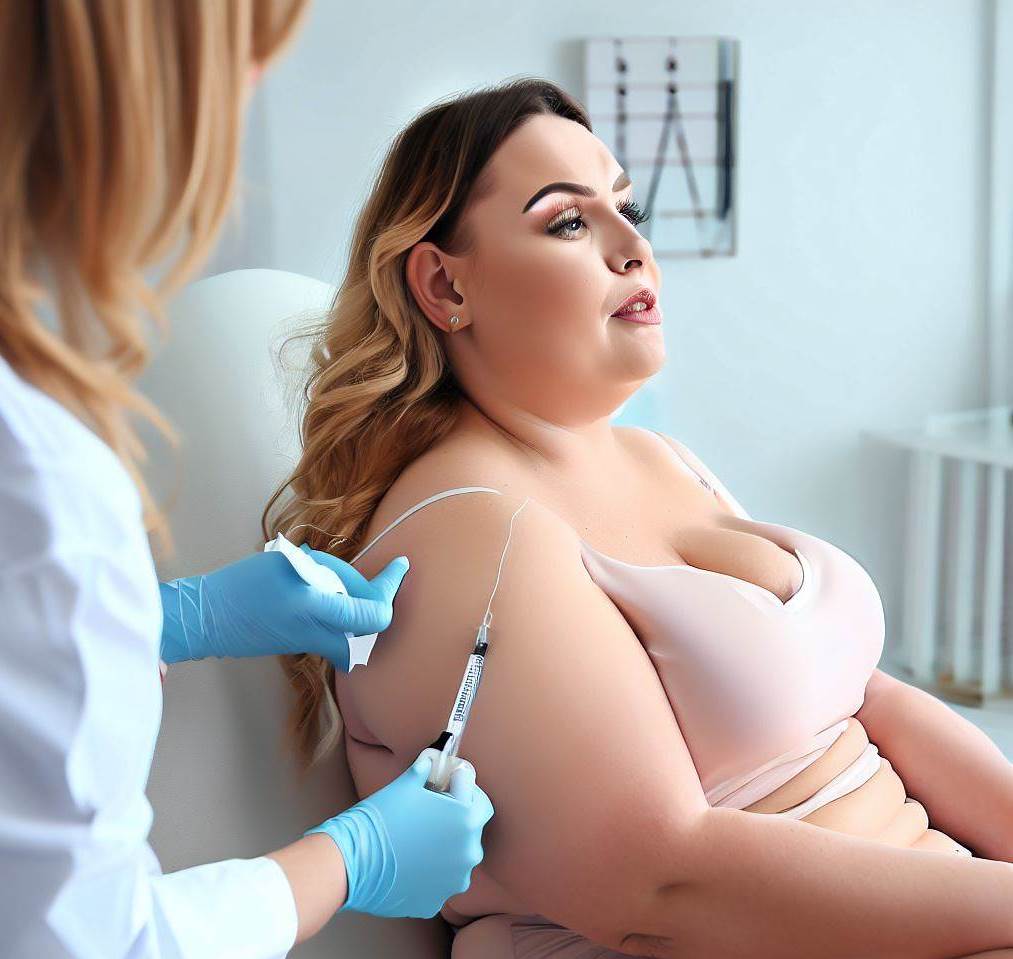Lipolysis Injections for Fat Reduction - Non Invasive Fat Loss
Are you looking for a non-surgical way to get rid of stubborn fat? Lipolysis injections might be the solution you've been searching for. Also known as injection lipolysis or lipodissolve products, these injections involve injecting a solution of phosphatidylcholine and deoxycholate into the targeted area.
The most common injection site for lipolysis is the iliac crest, which is the hip bone. This procedure works by breaking down and dissolving fat cells in the targeted area. It's considered a non-surgical alternative to liposuction, making it an attractive option for those who want to avoid invasive procedures.
Injection lipolysis has gained popularity in recent years due to its effectiveness and convenience. Unlike traditional weight loss methods, which can take months or even years to show results, lipolysis injections can provide noticeable changes in just a few sessions.
However, it's important to note that this procedure is not suitable for everyone. Before considering injection lipolysis, it's essential to consult with a qualified medical professional who can assess your eligibility and discuss any potential risks or side effects.
In this article, we'll delve deeper into what lipolysis injections are, how they work, and what you can expect from the procedure. We'll also explore reviews of injection lipolysis, pricing information, and answer some frequently asked questions about this popular cosmetic treatment.
So if you're curious about whether injection lipolysis could be right for you, keep reading!

Understanding the Purpose of Lipolysis Injections
Lipolysis injections are a popular cosmetic treatment that is used to reduce stubborn fat in targeted areas of the body. The purpose of lipolysis injections is to break down fat cells so that they can be eliminated by the body's natural processes.
How Lipolysis Achieves Its Purpose
Lipolysis injections work by injecting a solution into the targeted area that breaks down the fat cells. This solution typically contains phosphatidylcholine and deoxycholate, which are naturally occurring substances in the body that help to break down fat.
Once injected, these substances cause the fat cells to rupture and release their contents into the surrounding tissue. The body then eliminates these fatty acids through its natural metabolic processes.
The results of lipolysis injections are typically seen within a few weeks, as the body begins to eliminate the broken-down fat cells. However, it is important to note that lipolysis injections are not a substitute for a healthy diet and exercise. Rather, they are a complementary treatment for stubborn areas of fat that have not responded well to traditional weight loss methods.
Why Lipolysis Is Important
Lipolysis injections can be an effective way to reduce stubborn pockets of fat in targeted areas of the body. This can be especially important for individuals who have already made significant lifestyle changes but still struggle with certain problem areas.
For example, many people find it difficult to lose belly fat or love handles despite eating healthy and exercising regularly. Lipolysis injections offer an alternative solution for reducing these stubborn pockets of fat without resorting to invasive surgical procedures like liposuction.
Lipolysis injections are relatively safe and minimally invasive compared to other cosmetic treatments. While there may be some mild discomfort or swelling at the injection site, most people experience little to no downtime after receiving this treatment.
Mechanism of Action of Lipolysis Injections
Lipolysis injections are a popular cosmetic treatment used to reduce stubborn fat in specific areas of the body. But how do these injections work? Let's dive into the mechanism of action of lipolysis injections.
Breaking Down Fat Cells
Lipolysis injections contain a solution that triggers the breakdown of fat cells, also known as adipocytes. This solution typically contains phosphatidylcholine (PC) and deoxycholate (DC), which work together to break down cell membranes and release stored fatty acids.
Releasing Fatty Acids
Once the cell membranes have been broken down, the fatty acids are released into the surrounding tissue. These fatty acids can then be metabolized by the body for energy or transported to other tissues where they can be used as fuel.
Targeting Stubborn Areas
Lipolysis injections are often used to target stubborn areas of fat that are resistant to diet and exercise. Common treatment areas include love handles, thighs, and under the chin. By directly injecting the solution into these areas, lipolysis can break down targeted fat cells and reduce overall volume.
The Role of Phosphatidylcholine (PC)
Phosphatidylcholine is a naturally occurring compound found in soybeans, eggs, and other foods. It is also a key component in many lipolysis injection solutions. PC works by disrupting cell membranes and causing them to rupture, releasing their contents into surrounding tissue.
The Role of Deoxycholate (DC)
Deoxycholate is a bile acid that helps emulsify fats in the digestive system. When used in lipolysis injections, DC acts as an emulsifier, helping to break down fat cells and release their contents for metabolism.
Benefits of Lipolysis Injection Treatment
Lipolysis injections are a popular non-surgical treatment that can help reduce stubborn fat pockets that are resistant to diet and exercise. This treatment involves injecting a solution directly into the targeted area, which breaks down fat cells and makes them easier for the body to eliminate. In this section, we will discuss the benefits of lipolysis injection treatment.
Effective Results
One of the main benefits of lipolysis injections is their effectiveness in reducing stubborn fat pockets. The results of injection lipolysis can be seen within a few weeks after the first treatment session. Patients may notice a significant reduction in fat volume in the treated area, resulting in a more contoured and toned appearance.
Non-Invasive Treatment
Unlike other invasive procedures like liposuction, lipolysis injections are minimally invasive and require no downtime. Patients can resume their daily activities immediately after a session without any restrictions or limitations. This makes it an ideal treatment for those who have busy schedules and cannot afford to take time off work or other commitments.
Long-Lasting Results
Multiple treatments with lipolysis injections can lead to long-lasting results, making it a viable alternative to more invasive procedures like liposuction. The number of treatments required depends on each patient's individual needs and goals, but most patients see significant improvement after just one or two sessions.
Customizable Treatment
Lipolysis treatments can be customized according to each patient's individual needs and goals. The amount and frequency of injections can be adjusted based on the size and location of the treated area, as well as the desired results.
Safe And Reliable Treatment
Lipolysis injections are considered safe and reliable when performed by an experienced professional using high-quality products. However, as with any medical procedure, there is always some risk involved. It is essential to consult with a qualified healthcare provider before undergoing any type of treatment.
Side Effects and Risks Associated with Lipolysis Injections
Lipolysis injections, also known as lipolytic injections or fat-dissolving injections, are a popular cosmetic treatment used to eliminate stubborn pockets of fat. While these injections can be effective in reducing localized fat deposits, they also come with several risks and potential side effects.
Side Effects
One of the most common side effects associated with lipolysis injections is swelling, bruising, and pain at the injection site. This is because the injections cause trauma to the skin and underlying tissues. The severity of these side effects can vary depending on the patient's sensitivity to pain and their overall health.
Other possible side effects of lipolysis injections include:
-
Itching
-
Redness
-
Numbness
-
Tingling
-
Burning sensation
These side effects are usually temporary and will resolve on their own within a few days or weeks after treatment.
Complications
In addition to these common side effects, there are also several potential complications associated with lipolysis injections. These include infection, scarring, and uneven fat distribution.
Infection can occur if bacteria enter the injection site during or after treatment. Signs of infection include redness, swelling, warmth, pus drainage from the injection site, fever, chills, nausea or vomiting. If you experience any signs of infection after receiving lipolysis injections seek medical attention immediately.
Scarring may occur if too much product is injected into one area or if an inexperienced injector performs the procedure. Scars may appear raised or discolored and may take months to heal completely.
Uneven fat distribution occurs when too much product is injected into one area causing it to look lumpy or asymmetrical. This can be corrected by massaging the affected area or by undergoing another round of treatments.
Safety Concerns
There are also safety concerns related to lipolysis injections that patients should be aware of before undergoing the procedure. One of the biggest concerns is the use of unregulated or counterfeit products. These products may contain harmful ingredients that can cause serious health problems.
Another concern is the lack of long-term studies on their effectiveness and safety. While lipolysis injections have been used for several years, there are still many unknowns about their long-term effects.
Exploring the Effectiveness of Injection Lipolysis for Reducing Localized Fat Without Surgery
Injection lipolysis, also known as fat-dissolving injections, is a nonsurgical alternative to liposuction. It is a cosmetic procedure that involves injecting a solution into the subcutaneous fat, causing fat cells to break down and release fatty acids. This procedure can effectively reduce excess fat in areas such as love handles and fat pads.
How Does Injection Lipolysis Work?
The solution used in injection lipolysis typically contains phosphatidylcholine (PC) and deoxycholate (DC), which are naturally occurring substances found in our body. PC acts as an emulsifier, breaking down the fat cell membrane, while DC helps to dissolve the released fatty acids.
Once injected into the targeted area, the solution causes an inflammatory response that leads to the destruction of adipocytes (fat cells). The broken-down fat is then metabolized by the liver and excreted from the body over time.
Who Performs Injection Lipolysis?
Injection lipolysis should only be performed by a licensed medical professional who has experience with aesthetic plastic surgery or cosmetic surgery procedures. A qualified cosmetic surgeon will ensure that you are eligible for this procedure and will discuss your goals and expectations with you before treatment.
Who Is Eligible for Injection Lipolysis?
Injection lipolysis is suitable for individuals who have localized pockets of excess fat that are resistant to diet and exercise. However, it is not a weight-loss solution or a substitute for healthy lifestyle habits.
Candidates must be at least 18 years old and in good health with no underlying medical conditions that may interfere with healing or increase the risk of complications. Pregnant or breastfeeding women should avoid this procedure.
What Are the Benefits of Injection Lipolysis?
Compared to traditional liposuction, injection lipolysis offers several benefits:
-
Minimal downtime: This procedure is minimally invasive and requires little to no downtime, allowing patients to return to their daily activities immediately.
-
No general anesthesia: Injection lipolysis is typically performed under local anesthesia, which reduces the risk of complications associated with general anesthesia.
-
Targeted fat reduction: This procedure can effectively reduce excess fat in specific areas without affecting surrounding tissues or organs.
-
Nonsurgical alternative: Injection lipolysis offers a nonsurgical alternative to liposuction for those who prefer a less invasive approach.
Factors to Consider before Opting for Lipolysis Injections
Lipolysis injections, also known as fat dissolving or injection lipolysis, are a popular cosmetic procedure that involves injecting a solution into targeted areas of the body to break down and eliminate excess fat. While this treatment can be effective for some individuals, it is not suitable for everyone. Here are some primary factors to consider before opting for lipolysis injections:
Health History and Current Medications
Before undergoing any cosmetic procedure, it is crucial to take into account your health history and current medications. Certain medical conditions such as diabetes, liver disease, or blood clotting disorders may prevent you from being a candidate for injection lipolysis. Some medications such as blood thinners or aspirin may increase the risk of bleeding or bruising after the procedure.
Realistic Expectations of Results
While lipolysis injections can be an effective way to eliminate stubborn fat pockets in certain areas of the body, it is essential to have realistic expectations regarding the results. This treatment is not intended as a weight loss solution but rather as a way to contour specific areas of the body. Patients should expect subtle changes in their appearance rather than dramatic weight loss.
Cost and Potential Side Effects
Like any cosmetic procedure, lipolysis injections come with both costs and potential side effects. The cost can vary depending on the number of treatments needed and the size of the targeted area. Potential side effects include swelling, bruising, pain at injection sites, redness or itching at injection sites.
Male-Specific Considerations
Men considering lipolysis injections should keep in mind that they may require more treatments than women due to differences in muscle mass and body composition. Men also tend to have thicker skin than women which could impact how well they respond to treatment.
Procedure for Administering Lipolysis Injections
Lipolysis injections are a popular cosmetic procedure used to reduce localized fat deposits in various parts of the body. The procedure involves multiple treatment sessions, and the medication is injected directly into the targeted area. Here's what you need to know about how to use lipolysis injections and ensure safety during the process.
Treatment Sessions and Doses
The number of treatment sessions required varies depending on the individual's needs and goals. Generally, patients require multiple sessions spaced several weeks apart to achieve their desired results. During each session, a practitioner injects a specific amount of medication into the targeted area.
The total dose of medication is determined by the practitioner based on factors such as the size of the area being treated, the patient's weight, and medical history. It's important to follow your practitioner's instructions regarding dosage to avoid any complications or adverse effects.
Injection Process
Before administering lipolysis injections, practitioners may use a procedural image as a guide to help locate and target specific areas for injection accurately. This image can be helpful in ensuring that injections are placed precisely where they're needed.
During the injection process, practitioners use small needles to deliver medication directly into fat cells beneath the skin. The medication works by breaking down these cells and releasing fatty acids into the bloodstream for natural removal by the body.
Safety Precautions
While lipolysis injections are generally considered safe, there are some risks associated with this type of cosmetic procedure. To ensure safety during injection lipolysis, it's essential to choose an experienced practitioner who has undergone specialized training in administering these types of injections.
It's crucial to disclose any underlying medical conditions or medications you're taking before undergoing treatment with lipolysis injections. Certain health conditions or medications can increase your risk of complications during or after treatment.
Conclusion
Now that you know all about lipolysis injections, you can make an informed decision about whether they are right for you. Keep in mind the benefits of this treatment, such as reducing localized fat without surgery, but also be aware of the potential side effects and risks. Before opting for lipolysis injections, consider factors such as your medical history and overall health.
If you do decide to go ahead with this treatment, make sure to choose a qualified and experienced provider who follows proper safety protocols. By taking these precautions and understanding the process, you can achieve your desired results safely and effectively.
Remember to always prioritize your health and well-being when considering any cosmetic procedure.




